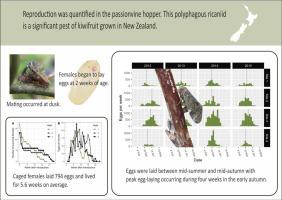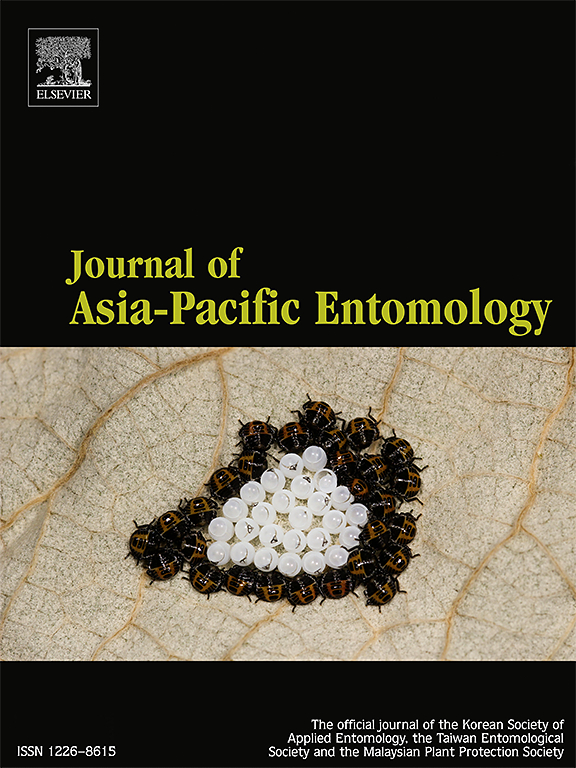入侵寄生蜂南棘虫产卵和繁殖行为的物候特征(半翅目:蠓科)
IF 1.3
3区 农林科学
Q3 ENTOMOLOGY
引用次数: 0
摘要
猕猴桃(Actinidia chinensis)是新西兰猕猴桃(Actinidia chinensis)的严重害虫。生产受到生长在蜜露覆盖的水果上的烟霉真菌的影响。PVH的生命周期为一年,卵是最长寿的越冬阶段。PVH生命周期的某些方面,如成人生殖行为,仍然相对不为人所知。本研究的目的是确定丰盛湾野生PVH种群产卵的时间,丰盛湾是新西兰主要的猕猴桃产区。在四年的时间里,用巴尔沙木棒在四个地点测定PVH的产卵量。产卵期为仲夏至中秋,产卵高峰期为3月中旬至4月中旬。经过1-2周的产卵前期,雌虫与雄虫关在一组中,并提供可选择的寄主植物,平均产卵794个。女性的平均寿命为5.6周,最长的为21周。雌性是同胚的,似乎能够快速发育卵母细胞,每周产卵一次以上。交配主要发生在黄昏之后;黄昏后产卵增加,但白天也观察到。这项研究提供了关于PVH生殖行为的新信息,这对于了解种群生态和制定涉及成人行为的管理方案非常重要。本文章由计算机程序翻译,如有差异,请以英文原文为准。

Phenology of oviposition and reproductive behaviour of the invasive plant hopper Scolypopa australis (Walker) (Hemiptera: Ricaniidae)
Passionvine hopper, Scolypopa australis (Walker)(PVH) (Hemiptera: Ricaniidae) is a serious pest of kiwifruit (Actinidia chinensis) grown in New Zealand. Production is affected by the sooty mould fungi that grow on honeydew-covered fruits. PVH have a one-year lifecycle, with eggs as the longest-lived and overwintering stage. Some aspects of the lifecycle of PVH such as adult reproductive behaviour remain relatively poorly known. The aim of this study was to determine when egg laying occurred in wild PVH populations in the Bay of Plenty, the main kiwifruit production region in New Zealand. PVH oviposition was determined using balsa wood sticks at four sites over four years. Eggs were laid between mid-summer and mid-autumn with peak oviposition from mid-March to mid-April. After a 1–2- week pre-oviposition period, females laid on average 794 eggs when caged in a group with males and provided with a choice of host plants. Longevity of females was on average 5.6 weeks with the longest-lived 21 weeks old. Females were synovigenic and appear capable of rapid oocyte development and laying batches of eggs more than once a week. Mating occurred predominantly after dusk; oviposition increased after dusk but was also observed throughout the day. This study provides new information on the reproductive behaviour of PVH that is important for understanding the ecology of the population and developing management options involving adult behaviour.
求助全文
通过发布文献求助,成功后即可免费获取论文全文。
去求助
来源期刊

Journal of Asia-pacific Entomology
Agricultural and Biological Sciences-Insect Science
CiteScore
2.70
自引率
6.70%
发文量
152
审稿时长
69 days
期刊介绍:
The journal publishes original research papers, review articles and short communications in the basic and applied area concerning insects, mites or other arthropods and nematodes of economic importance in agriculture, forestry, industry, human and animal health, and natural resource and environment management, and is the official journal of the Korean Society of Applied Entomology and the Taiwan Entomological Society.
 求助内容:
求助内容: 应助结果提醒方式:
应助结果提醒方式:


